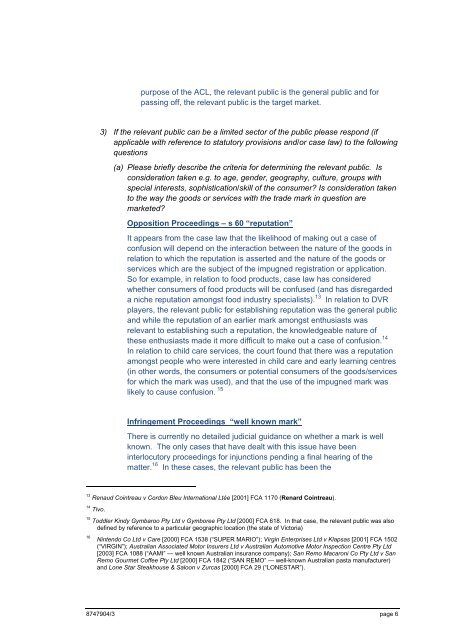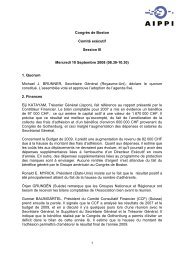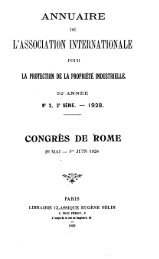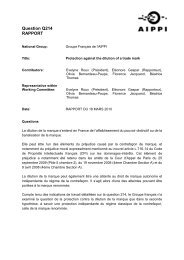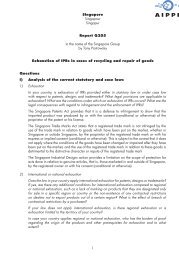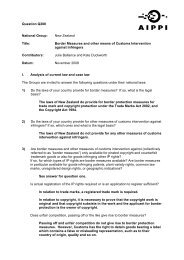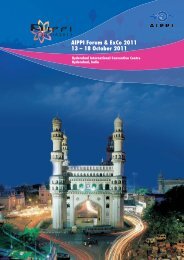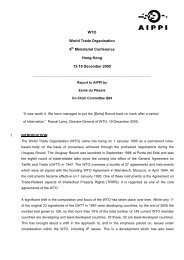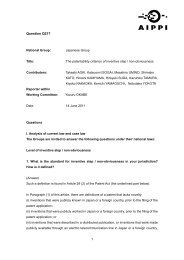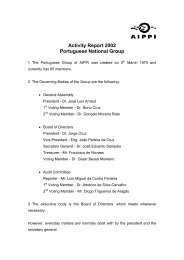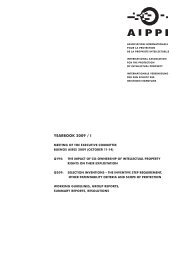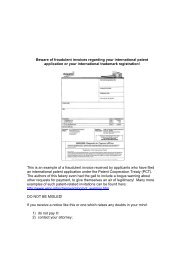Question Q234 National Group: Australia Title: Relevant ... - AIPPI
Question Q234 National Group: Australia Title: Relevant ... - AIPPI
Question Q234 National Group: Australia Title: Relevant ... - AIPPI
You also want an ePaper? Increase the reach of your titles
YUMPU automatically turns print PDFs into web optimized ePapers that Google loves.
purpose of the ACL, the relevant public is the general public and for<br />
passing off, the relevant public is the target market.<br />
3) If the relevant public can be a limited sector of the public please respond (if<br />
applicable with reference to statutory provisions and/or case law) to the following<br />
questions<br />
(a) Please briefly describe the criteria for determining the relevant public. Is<br />
consideration taken e.g. to age, gender, geography, culture, groups with<br />
special interests, sophistication/skill of the consumer? Is consideration taken<br />
to the way the goods or services with the trade mark in question are<br />
marketed?<br />
Opposition Proceedings – s 60 “reputation”<br />
It appears from the case law that the likelihood of making out a case of<br />
confusion will depend on the interaction between the nature of the goods in<br />
relation to which the reputation is asserted and the nature of the goods or<br />
services which are the subject of the impugned registration or application.<br />
So for example, in relation to food products, case law has considered<br />
whether consumers of food products will be confused (and has disregarded<br />
a niche reputation amongst food industry specialists). 13 In relation to DVR<br />
players, the relevant public for establishing reputation was the general public<br />
and while the reputation of an earlier mark amongst enthusiasts was<br />
relevant to establishing such a reputation, the knowledgeable nature of<br />
these enthusiasts made it more difficult to make out a case of confusion. 14<br />
In relation to child care services, the court found that there was a reputation<br />
amongst people who were interested in child care and early learning centres<br />
(in other words, the consumers or potential consumers of the goods/services<br />
for which the mark was used), and that the use of the impugned mark was<br />
likely to cause confusion. 15<br />
Infringement Proceedings “well known mark”<br />
There is currently no detailed judicial guidance on whether a mark is well<br />
known. The only cases that have dealt with this issue have been<br />
interlocutory proceedings for injunctions pending a final hearing of the<br />
matter. 16 In these cases, the relevant public has been the<br />
13<br />
Renaud Cointreau v Cordon Bleu International Ltée [2001] FCA 1170 (Renard Cointreau).<br />
14<br />
Tivo.<br />
15<br />
Toddler Kindy Gymbaroo Pty Ltd v Gymboree Pty Ltd [2000] FCA 618. In that case, the relevant public was also<br />
defined by reference to a particular geographic location (the state of Victoria)<br />
16<br />
Nintendo Co Ltd v Care [2000] FCA 1538 (“SUPER MARIO”); Virgin Enterprises Ltd v Klapsas [2001] FCA 1502<br />
(“VIRGIN”); <strong>Australia</strong>n Associated Motor Insurers Ltd v <strong>Australia</strong>n Automotive Motor Inspection Centre Pty Ltd<br />
[2003] FCA 1088 (“AAMI” — well known <strong>Australia</strong>n insurance company); San Remo Macaroni Co Pty Ltd v San<br />
Remo Gourmet Coffee Pty Ltd [2000] FCA 1842 (“SAN REMO” — well-known <strong>Australia</strong>n pasta manufacturer)<br />
and Lone Star Steakhouse & Saloon v Zurcas [2000] FCA 29 (“LONESTAR”).<br />
8747904/3 page 6


